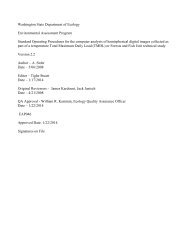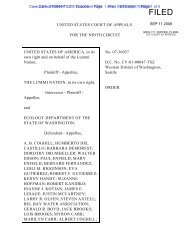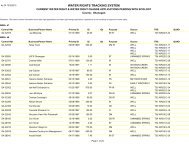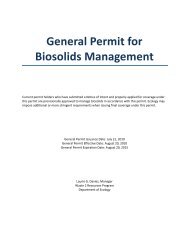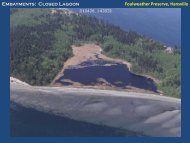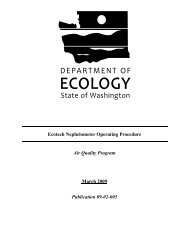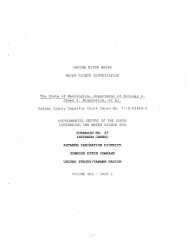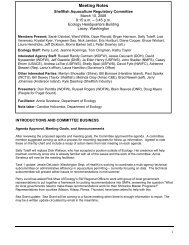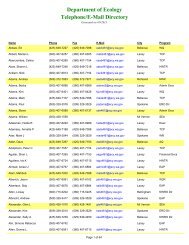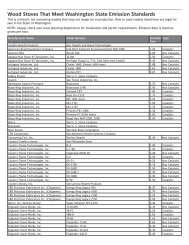WRIA 62 WMP 032305 - Washington State Department of Ecology
WRIA 62 WMP 032305 - Washington State Department of Ecology
WRIA 62 WMP 032305 - Washington State Department of Ecology
Create successful ePaper yourself
Turn your PDF publications into a flip-book with our unique Google optimized e-Paper software.
March, 2005 -64- 023-1289-003.3040<br />
County. Starting in 2008, the 5 year rotational survey will start again. As a component <strong>of</strong> this<br />
survey, the surveyor evaluates the Sanitary Control Area <strong>of</strong> the well for any potential contaminants.<br />
This is an element <strong>of</strong> a wellhead protection plan but is not a complete wellhead protection plan. If the<br />
Northeast Tri-County Health District identifies a high public health risk while conducting a sanitary<br />
survey, a schedule for the risk to be corrected is determined and tracked by WDOH. If the Northeast<br />
Tri-County Health District finds a deficiency in the survey, the Northeast Tri-County Health District<br />
works with the water system to address the deficiency. This JPO ensures that the water systems also<br />
create and implement plans to address water quality sampling, cross connection protection and<br />
coliform monitoring. However, the JPO does not address the fact that wellhead protection plans may<br />
not be developed or implemented by water systems in <strong>WRIA</strong> <strong>62</strong>.<br />
The Watershed Planning Unit discussed a number <strong>of</strong> options to address the fact that wellhead<br />
protection plans may not be developed or implemented by water systems in <strong>WRIA</strong> <strong>62</strong>. The<br />
Watershed Planning Unit decided to make a recommendation to identify these systems and encourage<br />
them to obtain technical assistance. The Watershed Planning Unit also agreed that including Group A<br />
and Group B public water system wellheads in the County’s Critical Areas Ordinance would help to<br />
reduce the potential for contamination. GIS coverages for Group A and Group B public water system<br />
wellheads are available from WDOH for use by the County.<br />
4.2.7 WQUAL-5 Background and Rationale<br />
Problem <strong>State</strong>ment: The 303(d) list identifies impaired waterbodies and requires <strong>Washington</strong><br />
<strong>State</strong> to work towards cleaning up impaired waterbodies and establishing TMDLs. However<br />
there is a need to identify an appropriate process to protect unimpaired waters in <strong>WRIA</strong> <strong>62</strong><br />
that meet or exceed applicable water quality standards .<br />
The intent <strong>of</strong> this issue and the corresponding actions is to “keep clean water clean and clean up dirty<br />
water” in the spirit <strong>of</strong> the 1987 revisions to the Clean Water Act. The goal <strong>of</strong> the Clean Water Act<br />
(CWA) is to “restore and maintain the chemical, physical and biological integrity <strong>of</strong> the Nation’s<br />
waters”. The CWA established the basic structure for regulating discharges <strong>of</strong> pollutants into the<br />
waters <strong>of</strong> the United <strong>State</strong>s. It gave EPA the authority to implement pollution control programs and<br />
also continued requirements to set water quality standards for all contaminants in surface waters. The<br />
Act made it unlawful for any person to discharge any pollutant from a point source into navigable<br />
waters, unless a permit was obtained under its provisions. It also recognized the need for planning to<br />
address the critical problems posed by non-point source pollution. Changes in 1987 created the <strong>State</strong><br />
Water Pollution Control Revolving Fund, more commonly known as the Clean Water <strong>State</strong><br />
Revolving Fund. This new funding strategy addressed water quality needs by building on EPA-<strong>State</strong><br />
partnerships. Evolution <strong>of</strong> CWA programs over the last decade has also included a shift from a<br />
program-by-program, source-by-source, pollutant-by-pollutant approach to more holistic watershedbased<br />
strategies. Under the watershed approach equal emphasis is placed on protecting healthy<br />
waters and restoring impaired ones. A full array <strong>of</strong> issues are addressed, not just those subject to<br />
CWA regulatory authority. Involvement <strong>of</strong> stakeholder groups in the development and<br />
implementation <strong>of</strong> strategies for achieving and maintaining state water quality and other<br />
environmental goals is another hallmark <strong>of</strong> this approach.<br />
In 1998, EPA policy was updated to better refine the water quality assessment process, requiring a<br />
complete Water Quality Assessment to be completed by states, as opposed to a listing <strong>of</strong> only<br />
waterbodies requiring a TMDL. In 2004, a draft <strong>of</strong> <strong>Washington</strong>’s first, more detailed Water Quality<br />
Assessment list was completed, which highlights existing and potential water quality problems across<br />
the state in addition to listing the traditional “303(d) list” waterbodies. This draft Water Quality<br />
<strong>WRIA</strong> <strong>62</strong> <strong>WMP</strong> <strong>032305</strong>



